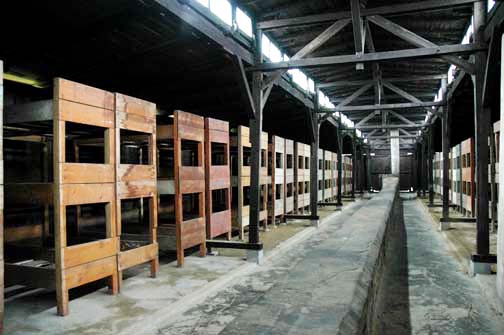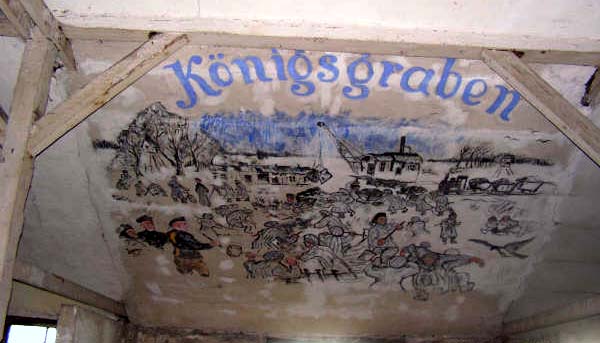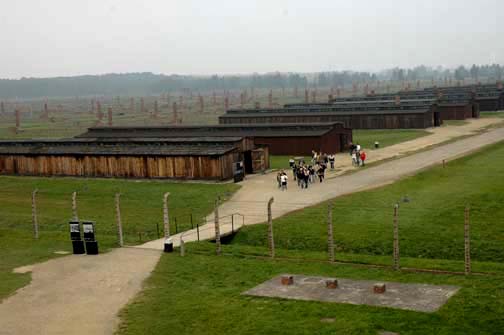Barracks at Birkenau

Early morning 1998
photo of Quarantine camp at Birkenau
The photograph above shows the wooden
barrack buildings in BIIa, the Quarantine section, at Auschwitz
II, also known as Birkenau. These are prefabricated horse barns,
typically used in concentration camps, and also for army barracks,
because they were easy to put up and to take down. In the background,
you can see the vast forest of brick chimneys, which is all that
is left of the barracks buildings on the north side of the Birkenau
camp. The Quarantine section faces a busy public road that runs
north and south past the Birkenau camp.
The interior of one of these barrack
buildings is shown in the photo below, taken in 2005. The brick
structure running down the center of the barracks is the stove.
 Interior of barracks
with brick stove down the center
Interior of barracks
with brick stove down the center
 Sign on rafter inside
barrack building.
Sign on rafter inside
barrack building.
The sign on the rafter inside one of
the barrack buildings reads "Sauberheit = Gesundheit."
In English this means "cleanliness is equal to good health."
The Jews who had to live in these filthy barracks were offended
by such signs since it was impossible for them to maintain any
semblance of cleanliness. They were expected to pick the lice
off themselves because "One louse means your death"
according to another sign. Particularly offensive was a sign
in the barracks which reminded the Jews to take off their caps
inside the building.
The photo below shows a painting on the
ceiling of one of the barracks buildings at Birkenau. It depicts
workers digging the Königsgraben canal.
 Painting done by an
inmate on the ceiling of a barrack building
Photo Credit: Bryan
Lynch
Painting done by an
inmate on the ceiling of a barrack building
Photo Credit: Bryan
Lynch
The Königsgraben canal was being
dug at the western end of the Birkenau camp in order to drain
the water, since the camp was built on swampy ground. A sign
in the barracks reads as follows:
A special penal company (Strafkompanie)
for men was housed in this barrack from May 1942 to July 1943.
These were mainly political prisoners, people for some reason
considered particularly dangerous to the Third Reich, prisoners
found guilty of breaking camp discipline, or those who were thought
to be participating in the camp's underground movement or planning
to escape. They were kept in complete isolation from the other
prisoners; even the daily roll-call and distribution of rations
were done separately in an enclosed yard next to the barrack.
Conditions in this unit were extremely harsh. Punishments were
severe, the workload murderous, and food rations reduced--all
leading to high mortality rate. One of the tasks of this unit
was to dig the main drainage ditch (Königsgraben). An original
drawing of this made by an unknown prisoner still remains on
the ceiling of this barrack.
 Early morning 2005
photo of Quarantine camp
Early morning 2005
photo of Quarantine camp
Pictured above is sector BIIa, the Quarantine
camp, taken from the tower of the gate house in October 2005.
Comparing this photo with the one at the top of the page, you
can see that display boards have been added, for the purpose
of explaining everything to visitors.
The information on all the displays makes
it clear that the Nazis did nothing humane: the prisoners were
initially housed in the Quarantine camp in order to establish
discipline, not to stop the spread of disease, according to the
display board. The hair was cut from the heads of the incoming
prisoners to humiliate them, not to control the lice which spreads
typhus. Practically every sign in the Birkenau camp makes a point
of mentioning the gas chambers and emphasizing the fact that
the Jews were sent immediately to the gas chamber, rather than
being registered in the camp. There are no death records for
the Jew who were not registered.
During World War I, four million people
died from typhus in Poland, and fifty million world-wide died
from the Spanish flu. At Birkenau, there was a grave danger of
an epidemic spreading to the SS guards in the camp, or even to
the German soldiers fighting on the Eastern front. This was the
reason for isolating new prisoners in the Quarantine barracks
for a period of time.
On December 28, 1942 a directive was
issued to all the Nazi concentration camps which included this
statement: "The Reichsführer SS [Heinrich Himmler]
has ordered that the death rate absolutely must be reduced."
This order referred to the death rate from typhus and other diseases.
The photo below shows the bunk beds in
one of the buildings in the Quarantine camp. Notice the uneven
construction of the bunks. The bouquet of flowers is on the brick
stove which runs the length of the building. The only windows
were near the roof.
 Flowers left by a visitor
in barracks building
Flowers left by a visitor
in barracks building
Men and women used the same latrines
in the Quarantine camp, one of which is shown in the photo below.
The toilets were nothing but holes in a concrete structure set
above the ground. There was no pit below the latrine; it was
only as deep as the height of the concrete structure. The prisoners
had to clean out the latrines when they were full. There was
no toilet paper available and the wash rooms were in another
building.
 Latrine in Birkenau
Quarantine camp
Latrine in Birkenau
Quarantine camp
|